The State Of Remote Work In 2021: A Survey Of The American Workforce
GoodHire surveyed 3,500 American workers to better understand the current state of remote work in 2021.
Resourcesarticles
Sara Korolevich
16 min read
Click a chapter to scroll directly to it.
With the COVID-19 pandemic waning, Americans share their feelings about returning to the office, pay cuts and benefits, general remote compensation issues, what it takes to recruit and retain quality employees, and other related feelings about their career paths, money, and life in the post-COVID-19 era.
The pandemic turned working from home (WFH) from a messy experiment with mixed results to an accepted and preferred working situation for a majority of American workers. GoodHire’s 2021 remote work survey brought us an abundance of data regarding workers’ feelings about what it would take to bring them back to the office and what they would give up to remain working at home. We also asked for employee input about the establishment of equitable return-to-office policies.
Now, in 2022 with the COVID-19 outbreak in decline and the US economy on the precipice of a possible recession, we wanted to know if employee feelings and motivations had changed in the past year, so we surveyed 3,500 adult Americans and asked if they still refused to return to the office; what they felt about pay cuts and the possibility of accepting reduced benefits in order to continue their current WFH job status; and an array of other questions about remote work in 2022 and beyond.
We discovered that a large number of workers are still interested in pay cuts to continue remote work, a huge group thinks that remote workers are at risk of losing their jobs first, and a big portion of American workers believe in-office workers should be paid more than their remote colleagues, and much more.
The 2022 results are eye-opening – and a few are in contrast with results from our 2021 survey – so let’s get right into the data.
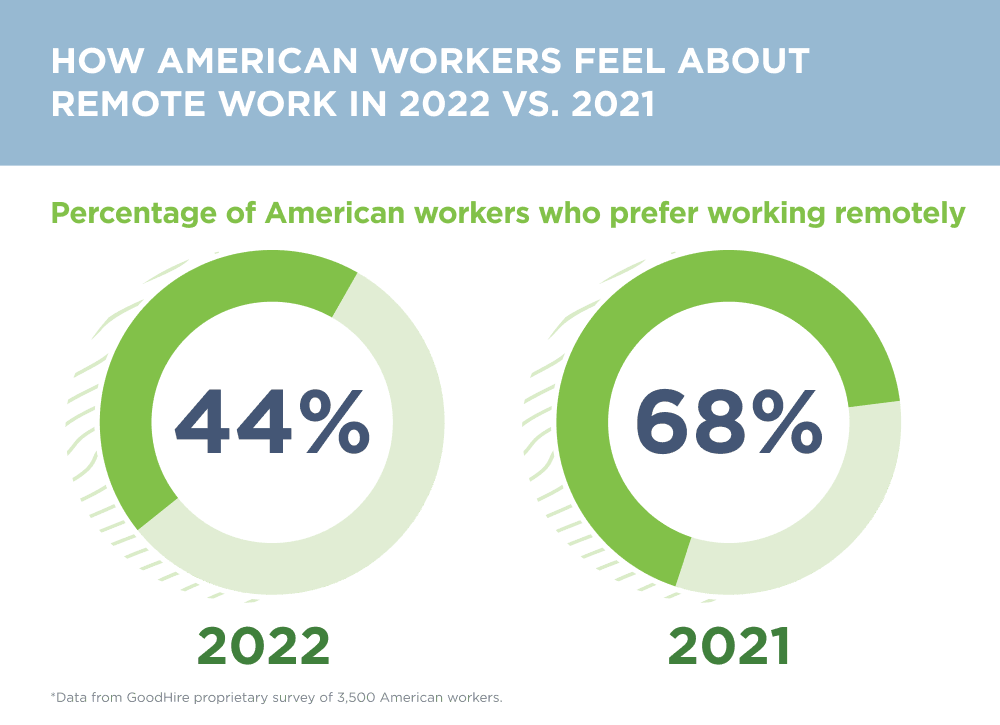
Pre-pandemic offices could be attractive places to work, with unlimited snacks, on-site health or child care options, daily free breakfasts and lunches. Some workers were able to schedule in-office massages and take company-approved on-premise naps.
Before the pandemic, many American workers had never worked remotely, but COVID-19 quickly forced a monumental shift to WFH, and in 2021, an impressive 68% of American workers — after a year of working remotely — said they would choose WFH over the office.
But in 2022, do workers still hate the office? Do the majority of workers still want to stay home? Apparently Zoom fatigue is real: only 44% said that they preferred working at home — a 24% decrease from our 2021 study. Additionally, 19% said they didn’t care and a significant 37% said they actually favored returning to the office.

Even though only 44% said they preferred to work at home, a whopping 89% of those surveyed still thought that most of their colleagues wanted to remain in a WFH situation. That percentage was virtually unchanged from 2021.
Regardless of employees’ thoughts about co-workers’ remote working preferences, under what circumstances would individual respondents be willing to go back to the office in 2022?
So, what about a mandated return to the office? In 2022, 33% stated they would either quit or start applying for a new job immediately if remote options were not available.
Comparatively, in 2021, 45% said they would start looking for a new job or quit if they were forced to return to the office.
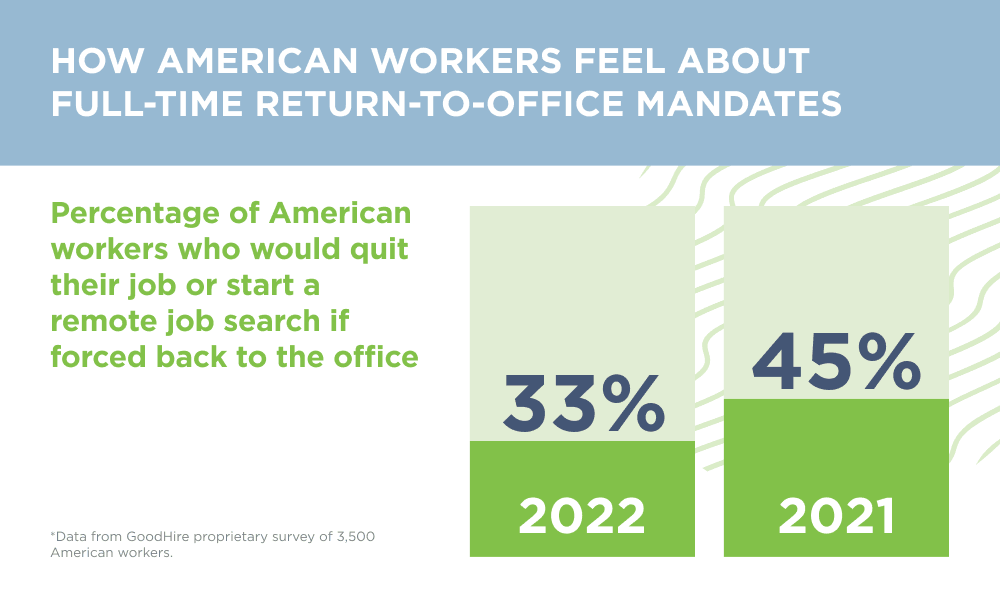
And finally, 54% of our 2022 survey-takers said that they would prefer a 4-day workweek in the office over a fully remote 5-day workweek at home. While remote working is great, a 4-day week looks really enticing to workers even if they have to be in the office to achieve it.
Some companies have threatened pay cuts for those that refused to return to the office. In 2021, 61% of our survey-takers said they would take a pay cut to maintain remote working status. This dropped quite a bit in 2022, as just 45% said they would take a pay cut for remote work.
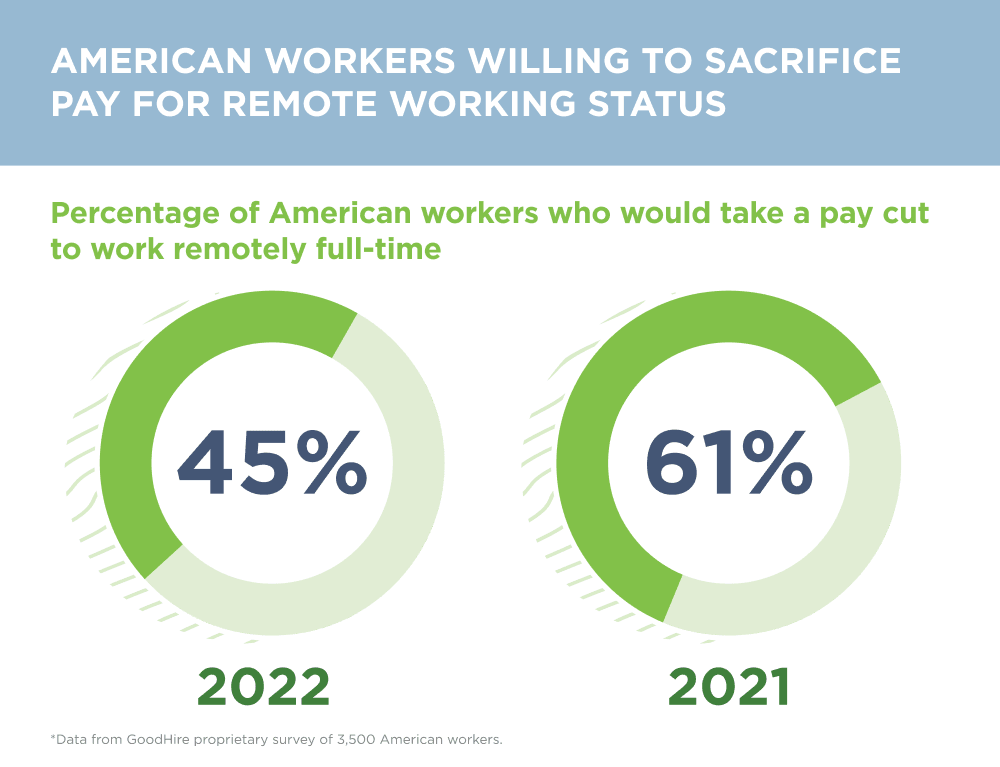
But what amount of pay would employees be willing to forgo? It turns out that 2022 workers surveyed felt comfortable with pay reduction rates from 5–15% maximum to maintain a WFH situation.
In 2021, 70% said they would forfeit some type of benefit for remote working status to continue, but we wanted to know their 2022 mindset and a good percentage of the respondents were adamant:
If employees are ordered into the office, they seem to want premium pay in exchange for an end to WFH.
An emphatic 73% (including undecided workers) said monetary incentives should be forthcoming as an enticement to return to the office.
On the other hand, some employees were concerned that WFH might be offered, but with a pay decrease. Over half (56%) of our respondents were worried that they could face reduced pay if they chose a remote situation; conversely, 44% said they weren’t concerned about a pay cut tied to working location.
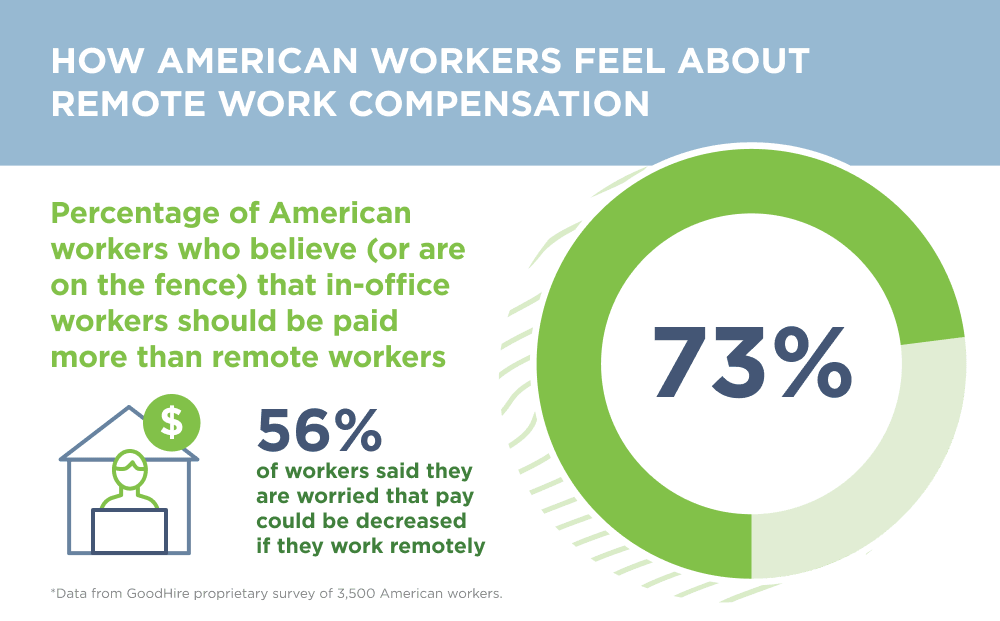
Out of sight and out of mind seems to apply to the remote vs. in-office playing field because workers feel that they might just need to be in the office in order to receive promotions and raises.
Even if pay cuts for remote working did not materialize, 84% of American workers surveyed think that they might be overlooked for promotions and pay raises in favor of people who worked in the office. This was certainly an overwhelming concern among American workers.
84% of American workers surveyed think that they might be overlooked for promotions and pay raises in favor of people who worked in the office.
On May 31st, 2022, Tesla decreed that all employees needed to return to the office ASAP. Some of those that refused were let go. We wanted to know if employees would even consider a job with a company that demanded 100% in-office attendance.
In 2021, 85% said they preferred to apply for jobs that offered remote work and just 15% said they’d apply for a job that required full-time office work. But what about now? We saw a significant 2022 shift as 63% of workers said they would consider applying for a non-remote job while 37% said they would not.
What about applying for a job that required 5-day per week in-office attendance? Surprisingly, 74% of today’s workers said they would apply, while only 26% said they would not.
If the genie cannot be put back in the bottle and some sort of remote work is inevitable, what did employees think was the minimum acceptable mix of remote vs. in-the-office? Three days per week in the office was the most common response followed by five days per week, and finally two days per week.
In this tight labor market, did workers think that companies would have a hard time getting people to apply if the companies did not offer remote work? In 2021, for example, 67% said companies would struggle if they didn’t offer remote work.
Employees stood their ground in 2022 as 63% agreed that inflexible companies would have a harder time attracting applicants while 37% felt that the lack of remote work scenarios was not a deal breaker.
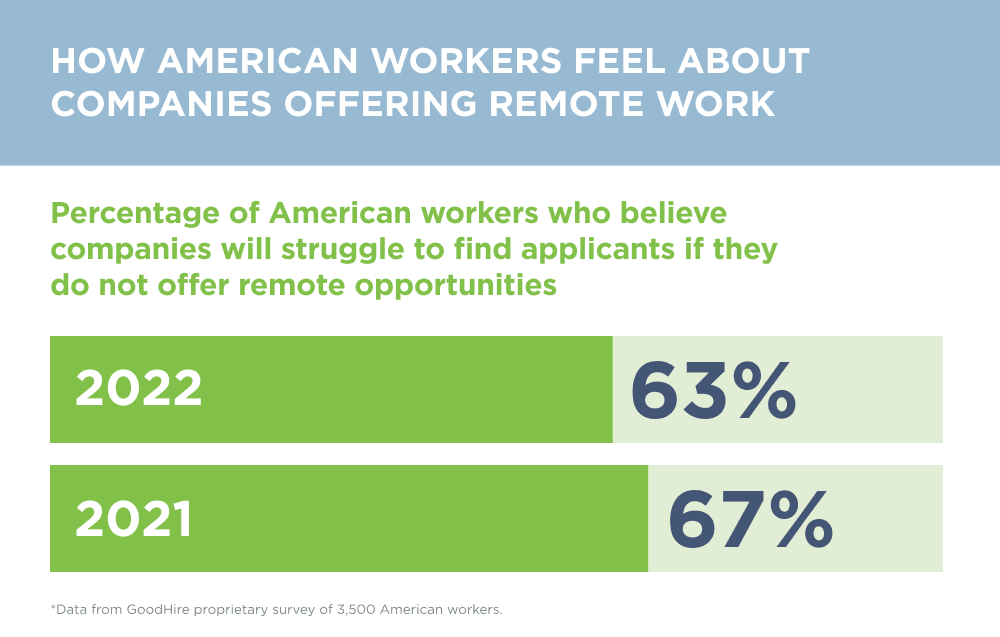
Then, if a company did not offer any kind of hybrid arrangement, would it have to pay higher salaries to attract pure in-office workers? 64% of 2021 survey takers said yes, and again, this figure hardly moved in 2022 as 61% agreed while 39% said that companies would not have to pay higher salaries to attract in-office workers.
The answer is yes.
The ability to prioritize work-life balance has been paramount for remote workers. The option to spend more time with family, see friends more frequently and improve self-care are just a few great representative perks of the WFH crowd.
That said, a lot of interaction and socialization occurs at the office. During the pandemic when most everyone was working remotely, tedious Zoom interactions and mandatory employee engagement activities were the rule. Now, in 2022, 59% of remote workers worried or were at least undecided as to whether they would be excluded from important team meetings and projects if they worked remotely rather than in the office. 41%, however, did not have the fear of missing out.
More importantly – and perhaps worrisome – 62% said that they were concerned about the effects of WFH on their general career progression, while 38% thought that their careers would progress whether in-office or working remotely.
A solid number of survey-takers (68%) were fearful or undecided that their managers viewed in-office workers as high performers while placing remote employees in the slacker category. 32% didn’t think that managers would use WFH vs. in-office status as a metric to influence their feeling about individual employee productivity.
There still seems to be a prejudice in favor of in-office workers vs. WFH employees as 66% of survey takers agreed or were on the fence regarding whether in-office workers should enjoy higher levels of job security than remote employees.
Conversely, a very significant 78% majority felt (or were undecided) that remote workers were more at risk of losing their jobs during a recession that would lead to layoffs than full-time office workers. Only 22% did not feel that remote workers were at a disadvantage if a recession occurred.
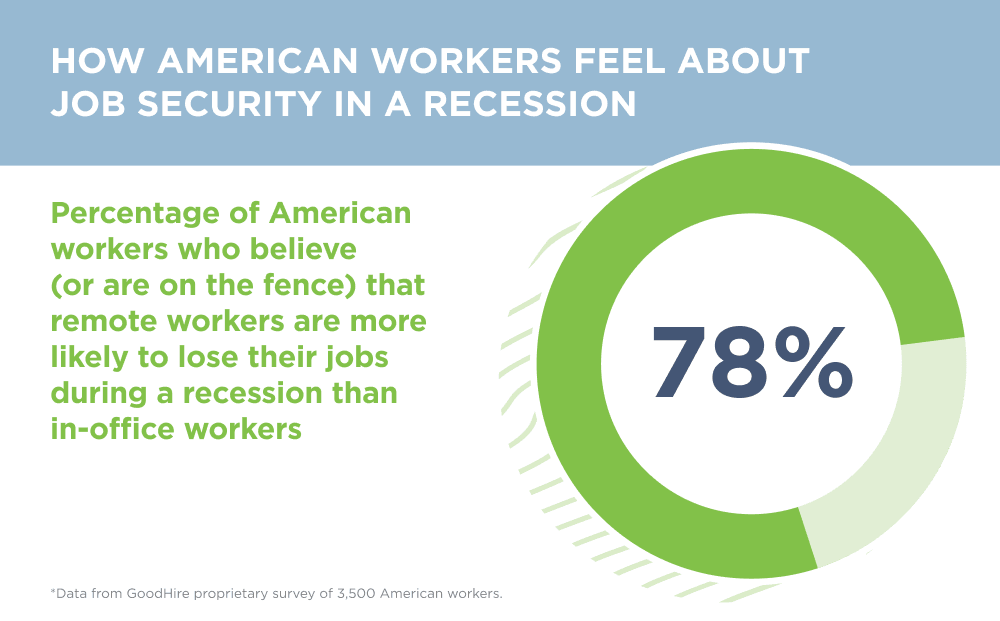
In 2021 we reported that “American workers absolutely love remote work. And most would prefer to work from anywhere but the office when COVID-19 restrictions are removed.”
We are seeing subtle sentiment shifts in 2022. For example, for those who preferred remote, only 44% are in favor now vs. a whopping 68% in 2021.
That said, 45% of remote workers would take a pay cut to continue their remote status. And the remote vs. in-office paradigm has led to some debate about work-week length as over half of 2022 employees would prefer a 4-day workweek even if this meant they had to be 100% in-office.
2022 workers are less apt to give up compensation in return for the ability to stay remote, but they were worried that this issue might rear its head. Also, remote workers were concerned that promotions might be given more readily to in-office workers.
In 2022, the ability to work remotely is not a set-in-stone demand, as many workers said they would apply to companies that required 100% in-office attendance. Workers did feel as though companies that offered a hybrid arrangement had the recruitment upper hand, however.
2022 workers did express concerns about missing out on office socialization and interaction, although 41% of survey takers didn’t think it was a big deal.
If a recession occurs, most survey respondents (78%) felt that remote employees would be first on the proverbial chopping block.
In 2022, some companies have taken a hard line and are attempting to minimize opportunities for remote work. Other companies, like Lyft and Atlassian, feel that hybrid situations are a win-win for everyone.
It’s important to remember that the US labor market is still extremely tight and when that situation inevitably straightens out with more competition for each job opening and applicants losing some of the leverage they currently have in both salary and working arrangement negotiations, some may cast remote work and WFH arrangements to the wind and be more apt to take a job that requires 100% in-office attendance.
For more information on GoodHire’s research or to request graphics about this study, please contact press@goodhire.com.
All data found within this report is derived from a survey by GoodHire conducted online via survey platform Pollfish. In Total, 3,500 adult Americans over age 25 were surveyed. The respondents were found via Pollfish’s age filtering feature. This survey was conducted over a two-day span from August 25-27, 2022, and all respondents were asked to answer all questions as truthfully as possible and to the best of their knowledge and abilities.
The resources provided here are for educational purposes only and do not constitute legal advice. We advise you to consult your own counsel if you have legal questions related to your specific practices and compliance with applicable laws.
Follow Me
As GoodHire’s managing editor, Sara Korolevich produces educational resources for employers on a variety of employment screening topics, including compliance and screening best practices, and writes about GoodHire’s company and product news. Sara’s experience stems from 20+ years working as a B2C and B2B PR and communications professional.
GoodHire surveyed 3,500 American workers to better understand the current state of remote work in 2021.
We surveyed 3,000 full-time workers, an equal number from ten of the most popular job sectors, to better understand the unique and sometimes poor relationship between managers and employees.
GoodHire identifies current management trends and preferred working models, potentially leading to “The Great Return.”